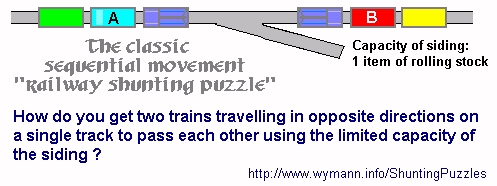SHUNTING PUZZLES THEORY |
||||||||||||||||
| Model
railway shunting puzzles are fun because they give a
sense to running trains by posing a challenge, and
finding the solution to this challenge is both satisfying
and entertaining. In this respect, shunting puzzles are
like any other puzzle. Therefore, in order to take a
"look behind the scene" and see how shunting
puzzles work, it is best to start with the general
question: What exactly is a puzzle? My favourite definition of "puzzle" actually has a few layers of dust to it, as it comes from the 1911 edition of the Encyclopedia Britannica. However, as puzzles aren't new, it still captures the essence in a miraculously short sentence:
Puzzles come in many forms and styles, such as riddles, mazes, jigsaws, blocks, rings, wires, and lots more. Some of the oldest "mechanical" puzzles come from China (perhaps the most familiar being the ch'i ch'iao t'u or Tangram), while the most well known historic European puzzle goes back to a tale from Ancient Greece, dating from 600 BC, and related by Sophocles and Apollodorus: The famous riddle of the Sphinx which sat on Mount Phikion and asked the Thebans "What has one voice, and is four-footed, two-footed and three-footed?" Unless giving the correct answer (which is "man" - crawling in his infancy, walking in his prime and using a stick in old age) you would be killed by the terrible Sphinx... The origins of the word “puzzle“ are disputed. It has been suggested that the verb to puzzle, which appears at the end of the 16th century, is derived from the noun apposal (meaning "opposition"), indicating "a question for solution". Others assume that the noun is in fact derived from the verb, which, in its earliest examples, means "to put in embarrassing material circumstances, to bewilder, to perplex". Some connection may also be found with a much earlier adjective poselet, meaning "confused, bewildered", which ceased to be used by the end of the 14th century. |
||||||||||||||||
Sequential movement puzzle + trains = "the shunting puzzle" |
||||||||||||||||
| Jerry
Slocum & Jack Botermans, who are the authors of a
scientific study of the history and principles of puzzle
games (Puzzles Old and New, University of
Washington Press, 1992), provide an in-depth look at sequential
movement puzzles. Sequential movement puzzles are related to the well-known solitaire or peg puzzles, as well as the famous Rubick cube. The solution to this type of puzzle requires a user to follow a series of sequential movements within a set of strict rules in order to arrive at a predetermined result. Many puzzles of this type first appeared during the 18th and 19th century in Europe, often devised by mathematicians because they involve certain principles of topology, number theory, and combinatorics. However, as most of these puzzles are intended to be fun, they can actually be solved with a very basic mathematical knowledge - very often, logic and trial-and-error are quite sufficient. One very famous such "mathematical puzzle" is in fact called the railway shunting puzzle. |
||||||||||||||||
|
||||||||||||||||
Model railway shunting puzzles - running a layout as a game |
||||||||||||||||
| Although it
will probably never be possible to determine where and
when a railway modeller had the idea to turn a model
railway layout into a puzzle for the first time, it is
fair to assume that this didn't happen out of
mathematical interest but as a result of trying to find a
way to increase the fun to be had in operating a model
railway layout. Most certainly, it was someone who liked
playing games and solving puzzles. All model railway shunting puzzles seem to belong to one of two different general types: sequential movement (where a pre-determined order needs to be formed) and distributional ordering (where items must be placed where they belong). |
||||||||||||||||
|
||||||||||||||||
Measuring complexity |
||||||||||||||||
| A question
which is often asked once the concept behind a shunting
puzzle layout has been explained is as to the degree of
complexity or, in other words: just how many possible
configurations are there? The mathematical approach to finding out how many permutations a specific shunting puzzle allows for is fairly easy. If "n" is the total number of cars on the shunting puzzle layout, and "k" is the amount of cars which are selected from this, then the formula to be used is
meaning that n factorial is divided through the factorial of n minus k (the “factorial” of three, for example, is 1 x 2 x 3 = 6, and written as "3!"). Applied to the original Inglenook formula (where 5 cars are selected froma total of 8), the calculation is as follows:
That is to say: the 8 cars can be arranged in 40,320 different ways on the Inglenook layout, and the number of possible trains with five cars which can be made up from these is 6,720. In other words: if you were to systematically work your way through these combinations, solving four shunting tasks in one hour, and doing that for three hours every evening, you would be at it for 560 operating sessions totalling 28 hours. |
||||||||||||||||
Page created: 24/FEB/2004 |










